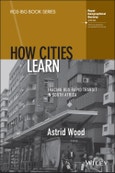How Cities Learn traces the circulation of bus rapid transit (BRT) to understand how and why it was widely adopted in South Africa.
- Investigates the global proliferation and localization of BRT
- Examines the production and distribution of transportation knowledge in the global south
- Addresses the spatial and social legacy of apartheid in South African cities
- Reveals a new way of understanding the intersections between policy, people and place
- Essential reading for scholars of geography, politics, sociology and transportation, as well as urban planners and practitioners
Table of Contents
List of Figures viii
List of Abbreviations x
Series Editors’ Preface xii
Acknowledgements xiii
1. Introduction 1
BRT Arrives in South Africa 1
Understanding the South African City 2
Transport Geography, Policy Mobilities and Learning in and from the South 5
Using Policy Mobilities as a Methodology 9
Structure of the Book 13
2. Geographies of Knowledge 16
Building an Analytic for Tracing 16
Tracing through Policy Models 18
Tracing through Actors and Associations 20
Tracing through Cities 23
Tracing through Temporalities 25
3. Translating BRT to South Africa 27
Introduction 27
The Geography of BRT 28
Forming the Bogotá Model of BRT 31
Introducing BRT in South African Cities 35
Johannesburg’s Rea Vaya 36
Cape Town’s MyCiTi 39
Tshwane’s A Re Yeng 41
Rustenburg’s Yarona 44
Nelson Mandela Bay’s Libhongolethu 45
eThekwini’s Go Durban! 46
A South African Interpretation of BRT 48
About the Station Platform 51
About the Bus 52
About the Bus Lane 53
About the Route 55
BRT and Taxi Transformation 58
The South African Taxi Industry 59
State Intervention in Transportation 61
Negotiating with Taxi Operators 65
Conclusion 68
4. Actors and Associations Circulating BRT 70
Introduction 70
An Analytic for Studying Policy Actors 71
Redefining the Role of Policy Actors 74
Policy Mobilizers of BRT Circulation 75
Intermediaries of BRT Circulation 78
Local Pioneers of BRT Circulation 81
Learning through Networks 85
Networks of Internationals 86
Networks of South Africans 88
Power Dynamics of Networks 94
Conclusion 96
5. The Local Politics of BRT 97
Introduction 97
The International Context of BRT Circulation 98
Learning from South America 99
Learning from Africa 102
Learning from India 105
Learning from the North 106
The National Context of BRT Circulation 107
Political Interactions between South African Localities 108
Technical Exchanges between South Africa Localities 111
The Municipal Context of BRT Circulation 114
Conclusion 117
6. Repetitive Processes of BRT Adoption 119
Introduction 119
Tracing Transportation Innovation in South Africa 120
Planting the Seeds of BRT in South Africa 124
Gradual Processes of Learning 127
Repetitive Processes of Circulation 128
Delayed Processes of Adoption 130
Transportation Innovations Not Adopted 133
Conclusion 138
7. Conclusion 140
Introduction 140
Reflecting on How Cities Learn 141
Reflecting on BRT in South Africa 145
Appendix A: Interview Schedule 147
Appendix B: Features of BRT systems in South Africa 154
References 166
Index 185








